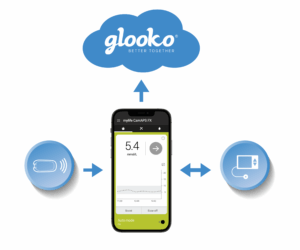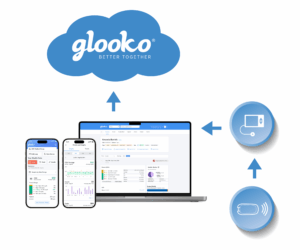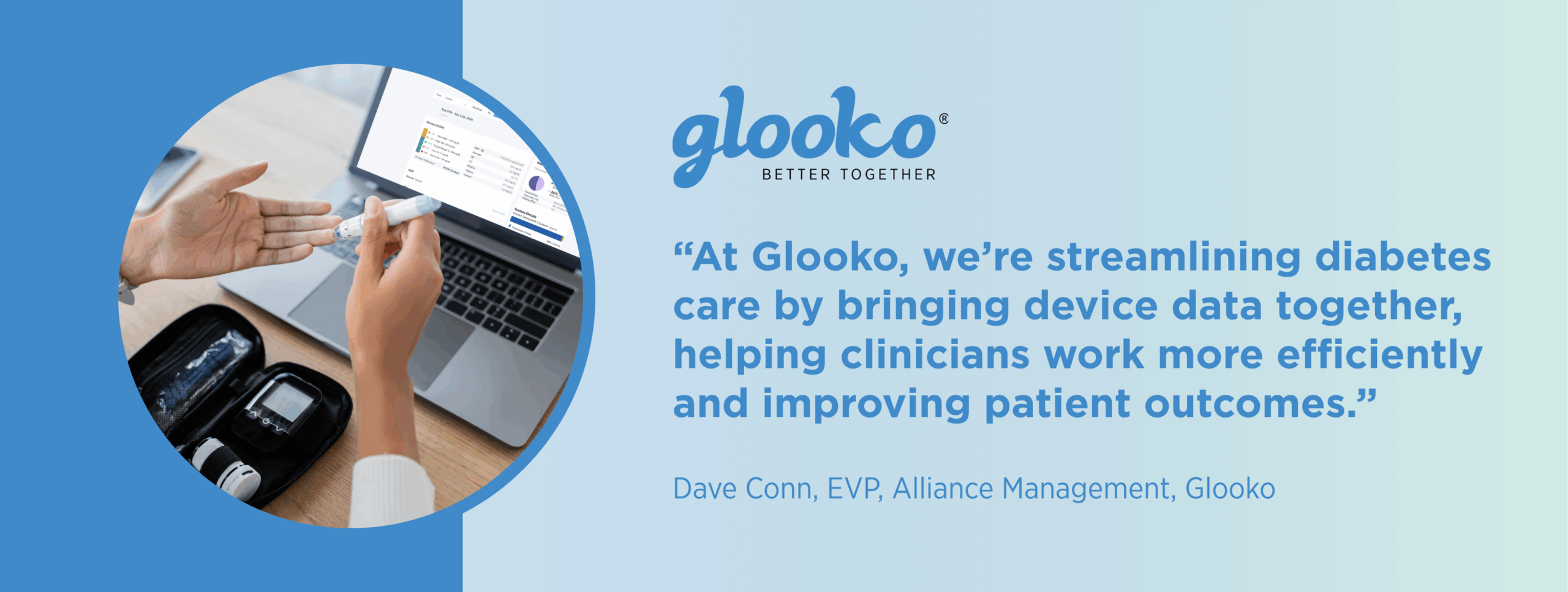
 Managing diabetes care has become increasingly complex for clinics, hospitals, and health systems. With a growing number of people living with diabetes relying on multiple devices — glucose meters, continuous glucose monitors (CGMs), insulin pumps, and wearables — healthcare providers face the challenge of piecing together critical data from siloed systems. This fragmentation not only consumes valuable time, but hinders patient care.
Managing diabetes care has become increasingly complex for clinics, hospitals, and health systems. With a growing number of people living with diabetes relying on multiple devices — glucose meters, continuous glucose monitors (CGMs), insulin pumps, and wearables — healthcare providers face the challenge of piecing together critical data from siloed systems. This fragmentation not only consumes valuable time, but hinders patient care.
At Glooko, we know device integration is the key to solving these challenges and transforming diabetes management. As a market leader in device compatibility, EHR integration, and interoperability, Glooko increases efficiency of clinical workflows by streamlining administrative tasks, enhances patient engagement, and helps deliver better outcomes.
The Challenges of Fragmented Diabetes Management
For healthcare providers, piecing together data from various devices and platforms and apps can feel like an endless puzzle. Without device integrations, clinics and health systems face:
- Disconnected Data: Patient data is scattered across incompatible platforms and apps, making it difficult to understand a patient’s holistic health.
- Inefficient Workflows: Healthcare providers must spend time manually entering or retrieving data instead of focusing their time and expertise to support their patients in achieving better health.
- Limited Patient Engagement: Patients often struggle to track their progress with so many different tools and apps, becoming overwhelmed and losing hope in their ability to make meaningful change.
These challenges contribute to missed opportunities for timely interventions that drive better health outcomes.
How Glooko’s Compatibility Brings Clarity to Diabetes Care
Glooko simplifies diabetes management by integrating data from more than 200 diabetes and health monitoring devices — including Abbott’s FreeStyle Libre CGMs in the U.S. — into a single, user-friendly platform.
Here’s how Glooko’s device compatibility transforms care:
- Data Integration and Interoperability: Glooko consolidates glucose levels, insulin usage, and lifestyle behaviors such as diet and physical activity, giving healthcare providers a holistic view of patient health. Care teams can easily access patient data from a centralized platform.
- Remote Monitoring Capabilities: Healthcare providers can track patient trends and progress between visits, ensuring timely adjustments to care plans and reducing unnecessary appointments and emergency room visits.

Not all devices are available in every country where Glooko is available. The product images are for illustrative purposes only. Not actual patient data. The sensor housing, FreeStyle, Libre, and related brand marks are marks of Abbott and used with permission. Important Safety Information: For full FreeStyle Libre systems safety information, please visit https://www.freestyle.abbott/us-en/safety-information.html.
The Many Benefits of Integration for Clinics, Hospitals, and Health Systems
Our industry-leading device compatibility benefits clinics, hospitals, and health systems by streamlining workflows and improving decision-making through a comprehensive view of patient data. With greater efficiency, care teams can focus more on patient care and expand their reach to serve more individuals in need.
- Streamlined Workflows: Staff spend less time on administrative tasks and more time on what they do best: educating and providing care to their patients.
- Improved Decision-Making: A comprehensive view of patient data allows care teams to create more personalized and effective treatment plans.
- Expanded Clinical Footprint: With more time, clinicians can help more patients in need.
To enable more meaningful data insights, Glooko also seamlessly integrates the health data from their patients’ diabetes and health monitoring devices directly into leading EHR systems, eliminating manual uploads and platform switching and reducing administrative burden.
The Key Benefits of Device Integrations for People Living with Diabetes
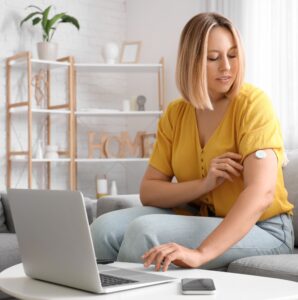
Glooko’s device integrations benefit people living with diabetes by simplifying their experience and empowering self-management through centralized data, reducing app overload and supporting informed health decisions.
- Simplified Experience: With integrated data, patients no longer need to juggle multiple apps and passwords, or manually report their glucose levels to their provider.
- Empowered Self-Management: Patients can log meals, exercise, and medications directly in the Glooko app, helping them understand how their choices impact their health.
Proven Results Backed by Global Expertise
Glooko has more than a decade of experience integrating diabetes and health monitoring devices worldwide, supporting millions of people living with diabetes. Glooko’s connected care platform, backed by real-world evidence, delivers the reliability, scalability, and insights clinics, hospitals, and health systems need to stay ahead in diabetes care, setting a new standard.
Simplify Diabetes Care with Glooko
The complexity of diabetes management doesn’t have to hold your clinic, hospital, or health system back. By choosing Glooko, you can eliminate data fragmentation, enhance patient care, and create a more efficient, streamlined experience for healthcare providers and people living with diabetes.
Schedule a personalized demo of our digital health platform today and see how your patients’ health data can be integrated directly into your EHR system.
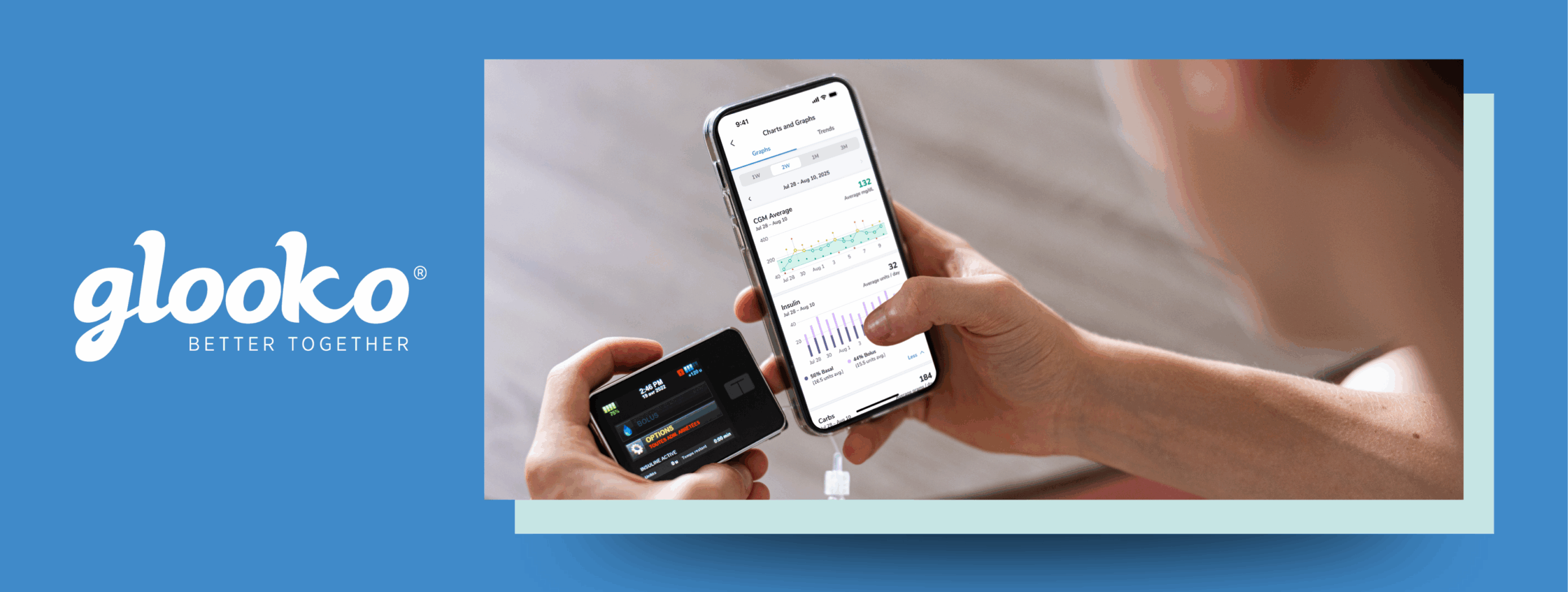
As a leader in diabetes management, Glooko offers an intelligent connected care platform that allow people with diabetes and their healthcare providers to review, analyze, and evaluate data from many different types of diabetes devices, including blood glucose meters (BGM), continuous glucose monitoring (CGM) systems, insulin pumps, smart pens, and fitness apps.
With Glooko’s digital health solution allowing users to view and analyze CGM and insulin data in one place, we have the ability to work with hybrid closed loop systems, a technology — often known as an artificial pancreas — that automates many of the daily decisions of people living with Type 1 diabetes who use an insulin pump and CGM that communicate with each other.
Innovative hybrid closed loop systems take readings from an individual’s CGM and use an algorithm to automatically tell the insulin pump how much insulin to deliver to keep blood glucose levels stable around the clock.
How Glooko integrates with hybrid closed loop systems
Our digital health platform, used by over 10,000 clinics in more than 30 countries, syncs via the cloud with leading diabetes CGMs and insulin pumps in hybrid closed loop systems to automatically present data around glucose levels, basal rates and more to patients and their care teams via graphically-oriented reports that can help recognize trends, so they can take action to improve their health outcomes.
The hybrid closed loop systems that currently sync with Glooko include:
- mylife Loop (CamAPS FX and Ypsomed)
- Tandem Control-IQ
- Insulet Omnipod 5
- Dana CamAPS® FX
Depending on the brands of the insulin pump and CGM, different methods of syncing via cloud are required to view data in Glooko from hybrid closed loop systems.
|
|
|
Like any great technology, people living with diabetes using a closed loop system still must check to ensure it is working and must count carbohydrates to give the system the correct bolusing data before food consumption. This is where the Glooko Mobile App’s food tracker can be used to track nutrition by searching the food database, using voice capture, or scanning a barcode (in select countries).
Benefits of using hybrid closed loop systems with Glooko
There are many benefits of using hybrid closed loop systems alongside Glooko for patients, including:
- Major changes in treatment that reduce daily burdens and mental stress
- More time with glucose levels in range with less effort
- The ability to visualize blood glucose and insulin data in clear graphs that make it easier to understand automatic boluses and basal rates
There are also many benefits of using hybrid closed loop systems alongside Glooko for care teams, including:
- An increased monitoring of patients with diabetes who are using closed loop systems
- Strengthening their connection with their patients
- Better management of fluctuations in patients’ glucose levels
- Easier interpretation of patient data around basal rate, automatic vs. manual mode and automatic boluses
The future of hybrid closed loop systems
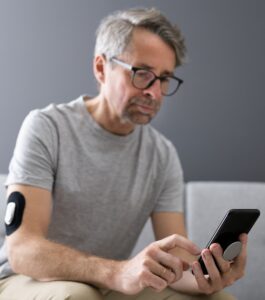
Hybrid closed loop systems in diabetes care are advancing toward more automation, intelligence, and accessibility. These systems are on a path toward becoming fully closed loop systems that will make managing diabetes more automated, adaptive, and accessible, allowing users to focus less on their condition and more on living life.
As the systems evolve, so will Glooko. With the regular introduction of new hybrid closed loop systems, Glooko will continue to partner with leading device manufacturers to integrate their platforms with our digital health solution.
For more information about using a hybrid closed loop system, consult with your healthcare team and explore resources from the Breakthrough T1D, Diabetes UK, and NHS England.
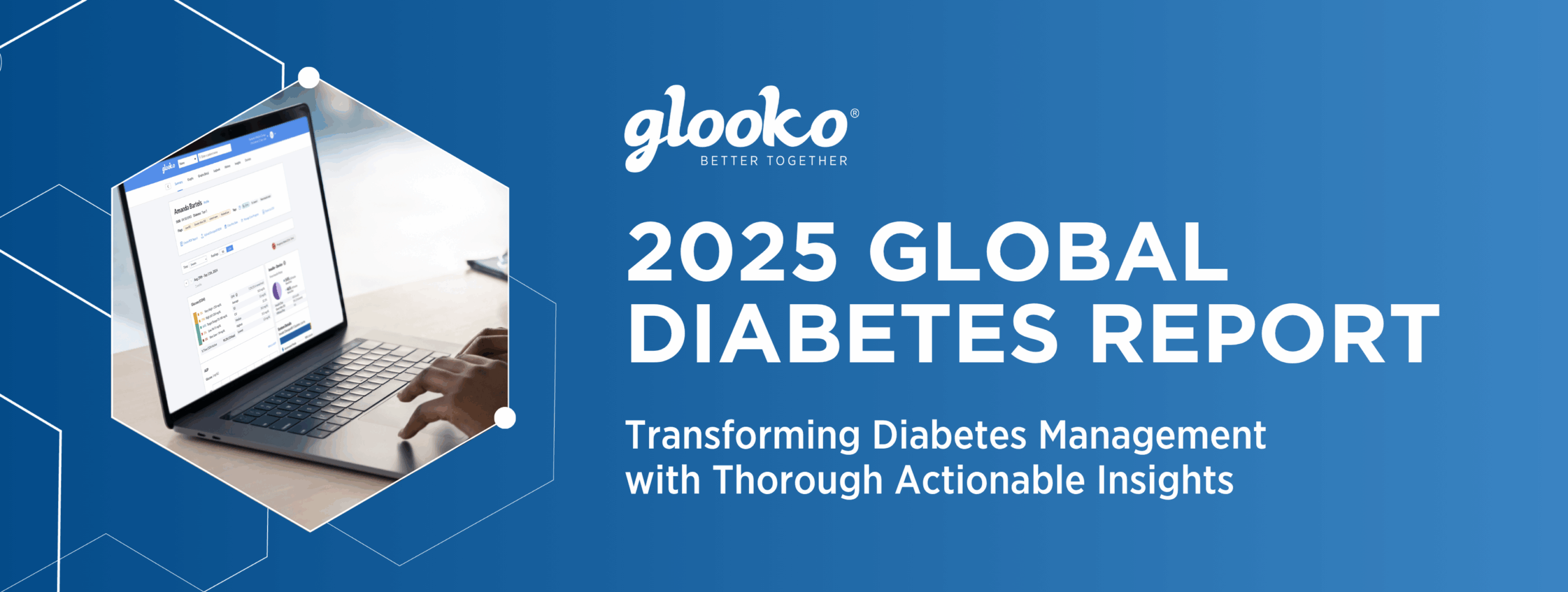
The Glooko 2025 Global Diabetes Report offers a comprehensive look at how real-world data can drive better outcomes in diabetes care. Powered by billions of data points across 30+ countries, this report uncovers meaningful trends in glycemic management, technology adoption, and behaviors among people living with Type 1, Type 2, and gestational diabetes.
From the rise of remote monitoring to the impact of advanced technologies like Continuous Glucose Monitors (CGMs) and Automated Insulin Delivery (AID) systems, this report explores how personalized insights can be used to better inform personalized care, predict risk, and guide clinical decision-making.
Whether you’re a clinician, researcher, or innovator in diabetes management technology, this report highlights how data can be turned into action — helping to shape a smarter, more connected future of diabetes management.

At Glooko, we are committed to simplifying diabetes insights and management for people living with diabetes and healthcare providers alike. That’s why our platform is compatible with more than 200 diabetes and health monitoring devices and growing.
As a company, we could not be more pleased to share that we recently expanded our capabilities to integrate with Abbott’s FreeStyle Libre CGMs in the United States. This integration brings glucose data to more clinics and health systems in our all-in-one solution for diabetes management.
This milestone is more than just a technological advancement — it’s about empowering people with Type 1, Type 2, and gestational diabetes, as well as prediabetes, to become active owners in their health. By combining the precision of Abbott’s FreeStyle Libre CGMs with Glooko’s comprehensive platform, we can provide people living with diabetes and their care teams, including endocrinologists and nurses, with a unified, holistic view of diabetes management and irrefutable information.
From glucose trends to lifestyle behaviors like diet and physical activity, this latest integration ensures that critical insights are easily accessible when and where they are needed most. For healthcare providers and health systems, this means the ability to seamlessly access and analyze patients’ CGM data through Glooko and established electronic health record (EHR) solutions, more informed decision-making, and improved patient outcomes. For people living with diabetes, it means greater confidence in their care and health.
As the number of people with diabetes continues to grow, the need for seamless, data-driven solutions has never been greater. Our new integration with Abbott’s FreeStyle Libre CGMs represents a significant step forward in delivering better, more connected care. This partnership is sure to have a positive impact on the millions of people who rely on FreeStyle Libre CGMs and Glooko.
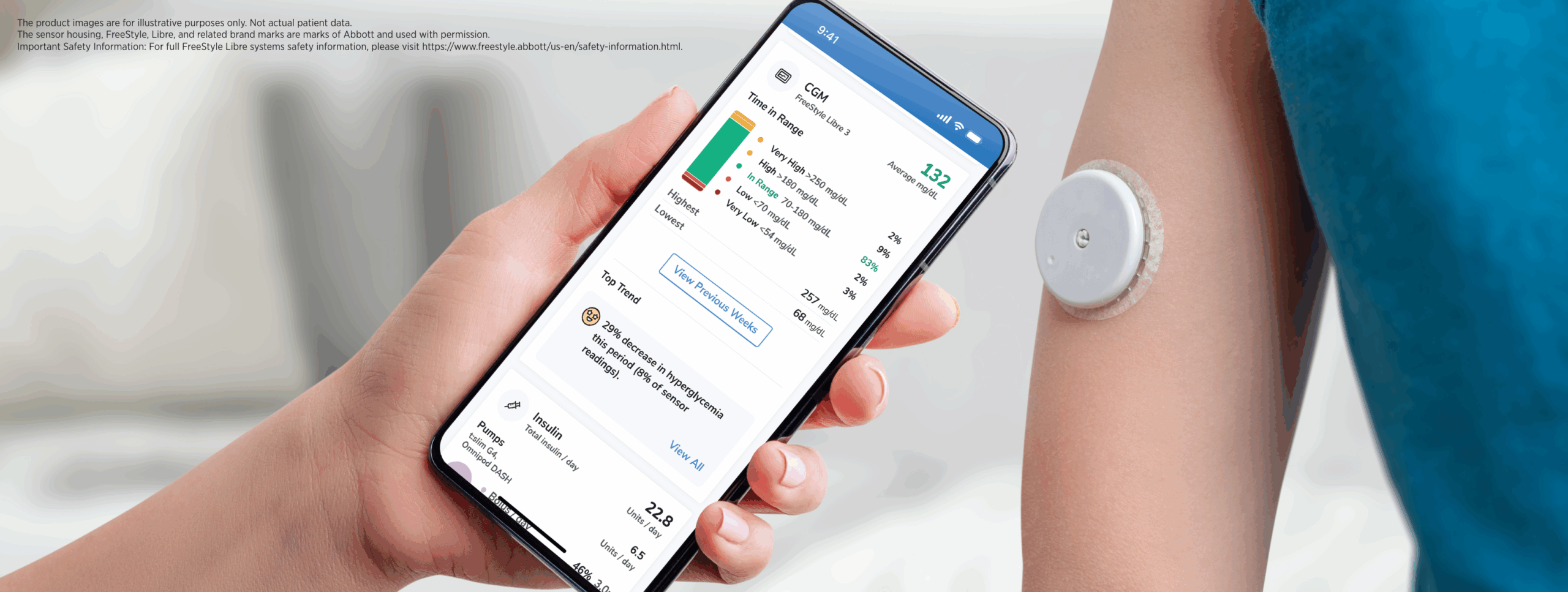
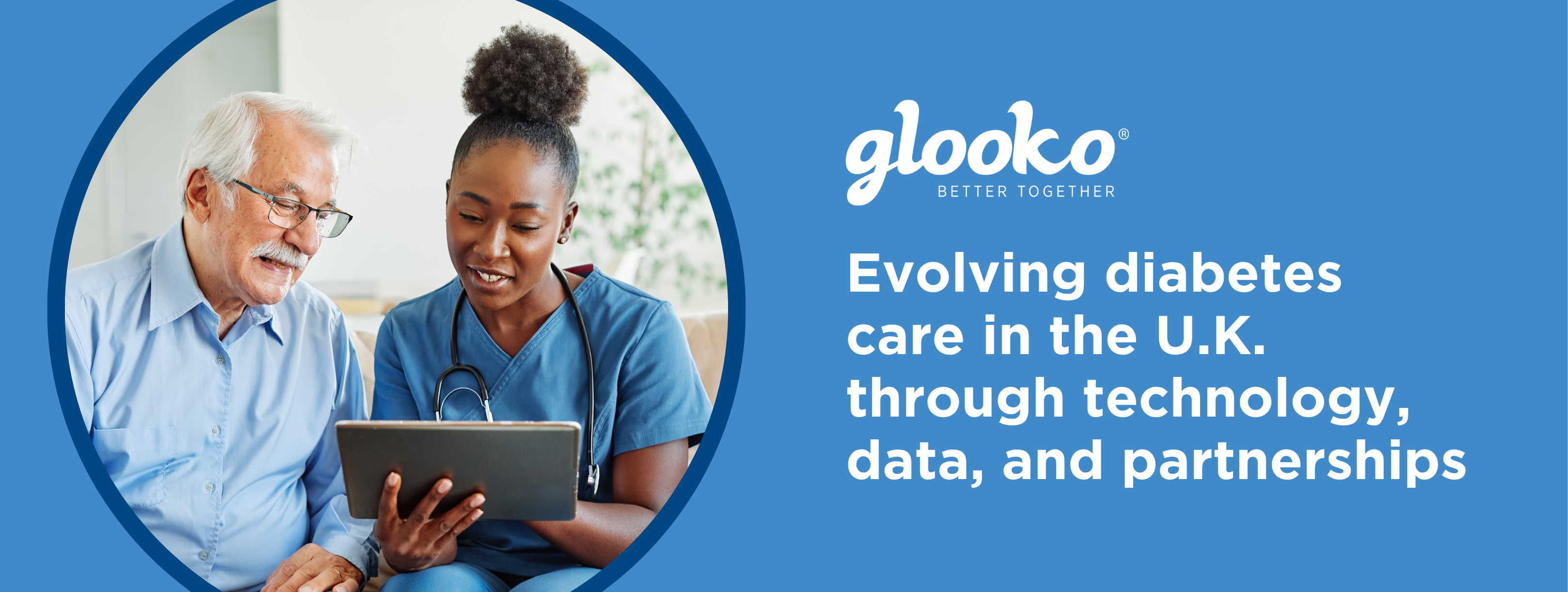
In the United Kingdom, diabetes technology has rapidly advanced over the past two decades, with platforms like Glooko playing a central role in simplifying care and management.
In honor of Diabetes Week U.K. (9 June to 15), we’re taking a look at the state of diabetes, technology designed to better manage the condition, and the outlook on the evolution of diabetes care and technology.
The State of Diabetes in the United Kingdom
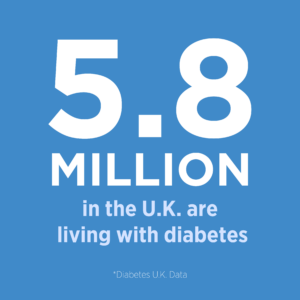 Diabetes is a significant public health concern in the U.K. According to Diabetes U.K., more than 5.8 million people are currently living with the condition. Of these, approximately 4.6 million have been diagnosed and an estimated 1.3 million people may be living with undiagnosed Type 2 diabetes.
Diabetes is a significant public health concern in the U.K. According to Diabetes U.K., more than 5.8 million people are currently living with the condition. Of these, approximately 4.6 million have been diagnosed and an estimated 1.3 million people may be living with undiagnosed Type 2 diabetes.
Of those diagnosed with diabetes in the U.K., Type 2 diabetes accounts for approximately 90% of cases. While risk factors for Type 1 diabetes include family history and the presence of other autoimmune conditions, Type 2 diabetes risk is heightened obesity, family history, a history of gestational diabetes, specific medications, and other factors.
To address the growing prevalence of diabetes and support those affected, the National Health Service (NHS) offers various education programs aimed at empowering individuals with the knowledge and skills necessary to manage their diabetes effectively, improve health outcomes, and reduce the risk of complications.
For individuals with Type 2 diabetes, programs like DESMOND (Diabetes Education and Self-Management for Ongoing and Newly Diagnosed) and the X-PERT Diabetes Programme provide education on managing the condition through lifestyle changes and self-monitoring. For those with Type 1 diabetes, the DAFNE (Dose Adjustment For Normal Eating) program offers guidance on insulin management and dietary considerations and Digibete helps young people, families, and communities better manage Type 1 diabetes. Additionally, the VICTOR program is designed for adults with Type 2 diabetes who are on insulin therapy and focuses on adjusting insulin doses in response to routine changes.
Diabetes Technology Today
In the U.K., diabetes technology is advancing quickly with Glooko helping streamline data management across compatible diabetes and health monitoring devices, including:
- Hybrid closed loop (HCL) systems, which combine continuous glucose monitoring (CGM) with insulin pumps to automatically adjust insulin delivery based on real-time data.
- Devices like Tandem t:slim X2 require cable downloads, while mylife Loop powered by CamAPS® FX and Omnipod® 5 use cloud-to-cloud integration.
- CGMs provide glucose trends and alerts and are often compatible with pumps and cloud platforms.
- Abbott FreeStyle Libre CGMs data can be seen within Glooko through the upload of data from HCL-compatible insulin pumps.
- Fitness and health monitoring apps can track steps, weight, and blood pressure.
- Smart pens and connected pens allow for remote or in-clinic dose tracking.
Transforming Diabetes Care in the United Kingdom with Glooko

Across the country, more than 85,000 people living with diabetes use Glooko’s digital health platform to manage their diabetes and more than 500 clinics are using Glooko to provide better care to their patients.*
Through our data*, we identified key metrics for time in range for people with Type 1, Type 2, and gestational diabetes in the U.K. using Glooko during 2024.
|
Type |
Time In Range (TIR) | 3.9-10 mmol/l |
Time in Tight Range (TITR) | 3.9-7.8 mmol/l |
|---|---|---|
|
Type 1 Diabetes |
64% |
41% |
|
Type 2 Diabetes |
58% |
34% |
|
Gestational Diabetes |
74% |
50% |
Today, there is an increased interest in TITR and TIR as a result of the recent technology available for managing diabetes. The Glooko diabetes data management platform helps healthcare providers monitor TIR and TITR to improve glycemic outcomes for people living with diabetes, bringing data from multiple devices into one platform with comprehensive charts and graphs. It ensures consistent data access — even without connected devices — and meets high standards for data protection, including GDPR compliance, to support safe, effective, and standardised diabetes care.
The Future of Diabetes Care in the United Kingdom
The future of diabetes care in the U.K. lies in advancing technology and deeper collaboration. Recent key developments include moving towards fully closed loop systems, integrating AI-enabled personalized insights, and aligning diabetes management with weight loss medications. Continued innovation will help provide more tailored, effective treatment options for people living with diabetes.
Progress also depends on strong partnerships with leading diabetes organisations like the Diabetes Technology Network (DTN-UK) and Diabetes National Networking Forums (NNF).
The future of diabetes care in the U.K. lies in advancing technology and deeper collaboration. Recent key developments include moving towards fully closed loop systems, integrating AI-enabled personalized insights, and aligning diabetes management with weight loss medications. Continued innovation will help provide more tailored, effective treatment options for people living with diabetes.
 By showcasing technologies such as hybrid closed loop systems at local events from these leading organisations and through initiatives like our Academy program, a collaboration between Glooko and the Association of British Clinical Diabetologists(ABCD)/DTN-UK providing free education for medical professionals in the U.K., we help educate, support, and empower both clinicians and people living with diabetes across the country.
By showcasing technologies such as hybrid closed loop systems at local events from these leading organisations and through initiatives like our Academy program, a collaboration between Glooko and the Association of British Clinical Diabetologists(ABCD)/DTN-UK providing free education for medical professionals in the U.K., we help educate, support, and empower both clinicians and people living with diabetes across the country.
*Internal Glooko data; based on active Glooko users that synced during 2024
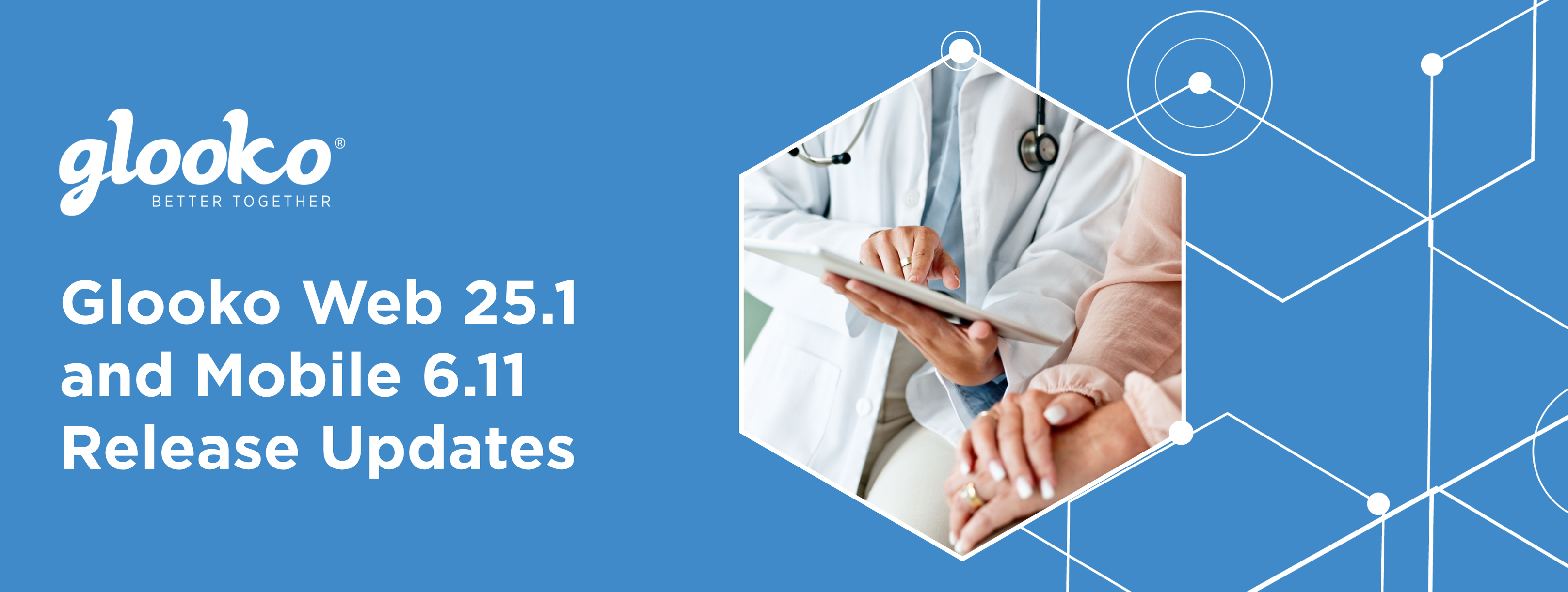
As part of our ongoing commitment to supporting healthcare providers and people living with diabetes, we’re excited to share the latest enhancements and features now available in Glooko Web 25.1 and Mobile 6.11. These updates are designed to streamline workflows, improve patient engagement and security, and provide care teams with more robust tools to manage diabetes care effectively.
Patient Notes and Medications in Week View
Care teams and people living with diabetes can now view notes and medication entries added to the Glooko Mobile and Web App directly in Week View, both online and in PDF reports. These entries appear in a new collapsible “Events” section below each day, making it easier to contextualize trends in glucose data and treatment behaviors.
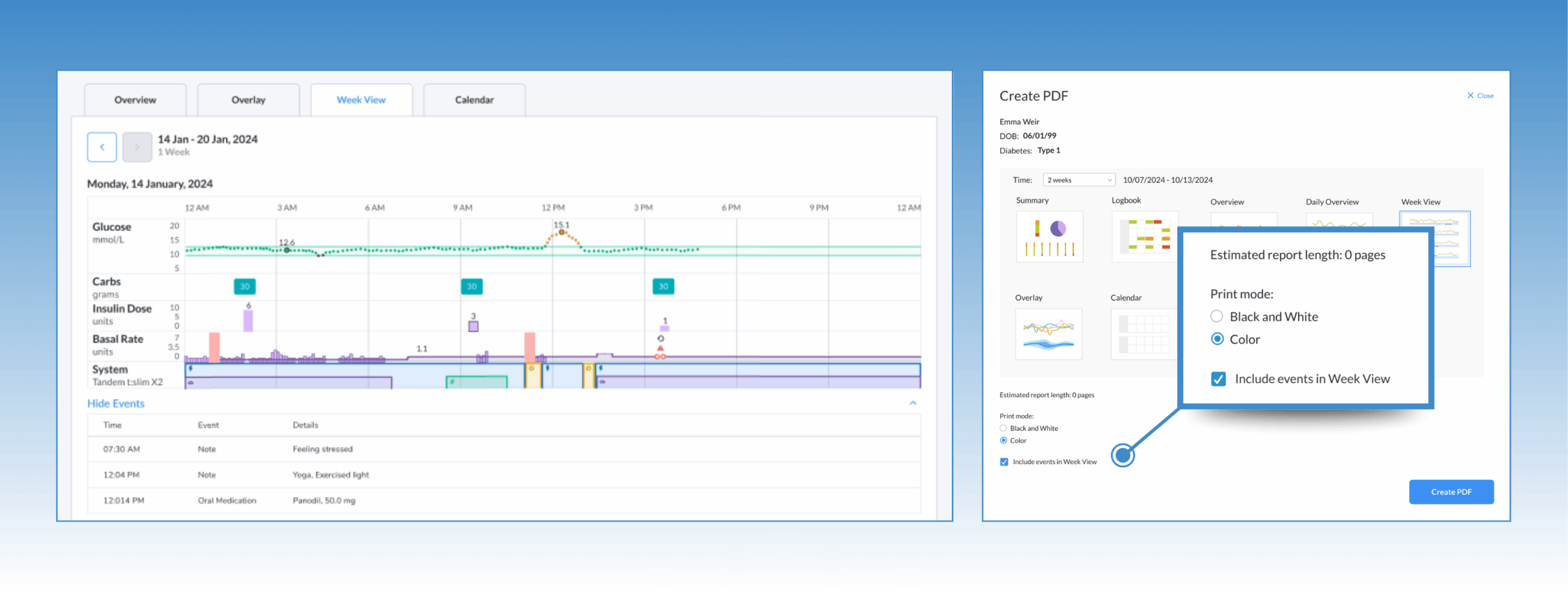
Streamlined Week View PDF Reports
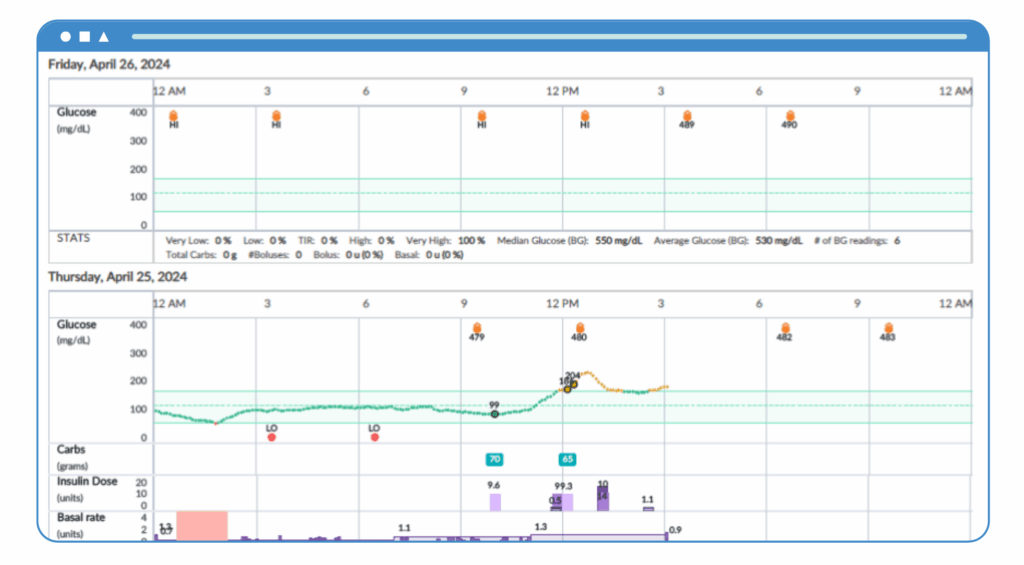 In our new release, Week View PDFs are now cleaner and more efficient. Sections without data will be automatically hidden, allowing more patient data over a few days to fit on each page.
In our new release, Week View PDFs are now cleaner and more efficient. Sections without data will be automatically hidden, allowing more patient data over a few days to fit on each page.
The glucose and statistics sections will always remain, and a single, comprehensive legend will now appear at the end of the report.
Smarter Defaults in the PDF Wizard for Hybrid Closed Loop Systems
Designed to streamline reporting workflows and help care teams quickly access the most meaningful insights, the Glooko PDF Wizard now automatically pre-selects the most relevant reports, including Summary, Week, Daily, and Devices, when a patient uses a Hybrid Closed Loop System like Omnipod® 5, Tandem t:slim X2 with Control-IQ technology, or mylife Loop powered by CamAPS® FX.
Care teams can still customize the selections as needed.
Enhanced Security in the Glooko Mobile App
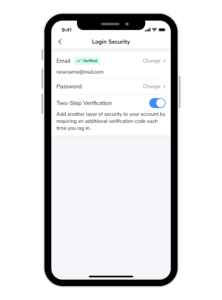 At Glooko, we’re committed to the security and safety of our platform users.
At Glooko, we’re committed to the security and safety of our platform users.
People living with diabetes, including those under age 18, can now manage their login credentials (email and password) through a new Login Security section in the Glooko Mobile App’s Account Settings. We’ve also expanded support for two-factor authentication (2FA) to users to ensure an extra layer of protection.
Explore More Updates
For more detailed information about the new features designed to simplify diabetes management, be sure to check out the full release notes on the Glooko Support Center.


As healthcare providers, we find ourselves at a pivotal moment in diabetes management. Technological advances — from remote patient monitoring to artificial intelligence — have dramatically reshaped patient care. Yet, amid these innovations, a crucial element often remains overlooked: the voices of clinicians and people with diabetes.
In my new expanded role as Chief Medical and Strategy Officer at Glooko, I am excited about the opportunity to transition from direct patient care into a broader role where I can continue to make a significant impact on diabetes management and improve the lives of people with diabetes. I believe my firsthand clinical experience positions me uniquely to guide Glooko’s innovation efforts, ensuring we build tools that genuinely meet the needs of clinicians and people with diabetes alike.
In my nearly two decades as a pediatric endocrinologist, I’ve observed the profound potential—and the challenges—of integrating digital solutions into daily diabetes management. Clinicians routinely manage a complex array of tasks: reviewing glucose data from continuous glucose monitors (CGMs) or meters, adjusting insulin regimens, coaching patients on lifestyle, documenting clinical decisions, and coordinating across care teams. With a single person’s CGM device generating up to 288 data points per day, 1 clinicians managing numerous people with diabetes face overwhelming workloads.
Individuals with diabetes echo similar concerns. Many describe data fatigue from constant management and analysis of their glucose levels. As one person stated, “The data is overwhelming; without clear insights and simpler ways to interpret it, it’s just noise.”
Although this wealth of data is invaluable, it contributes significantly to clinician burnout, and burn out among people with diabetes. Alarmingly, half to two-thirds of clinicians experience burnout, driven largely by bureaucratic tasks, extended working hours, and the sheer volume of data management.2,3
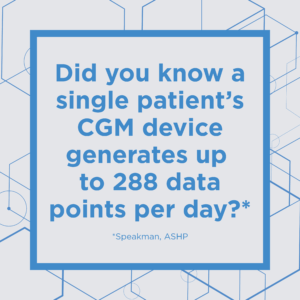
Individuals with diabetes also report significant stress from managing their condition daily. Every glucose reading can feel like a pass or fail test. Effective technological integration could alleviate such emotional burdens by making data actionable, intuitive, and less intrusive.
At Glooko, we recognize that technology alone is not sufficient—it must seamlessly integrate into clinician workflows. Clinicians offer essential insights into behaviors of individuals, adherence barriers, and preferences. Unfortunately, many digital diabetes solutions miss the mark due to inadequate clinician input, leading to underutilization—only about 40% see active clinical use.4 Glooko addresses this by ensuring clinician insights directly shape our technology, streamlining workflow integration through interoperability with electronic health records (EHRs).
In a similar vein, simplicity and intuitive user experiences are paramount for people with diabetes to properly leverage diabetes management technologies. If the technology is complicated, it just becomes another barrier.
Today, our connected care platform exemplifies this integrated approach, merging patient-generated data with clinical decision-making tools. Evidence demonstrates connected care significantly improves diabetes outcomes, with reductions in HbA1c levels of up to 1.5% and fewer hypoglycemic events.5 Glooko enables clinicians to swiftly identify high-risk trends and proactively manage care for people with diabetes.
Tomorrow, AI-driven predictive analytics within Glooko could transform diabetes management by forecasting hypoglycemic and hyperglycemic events, facilitating timely, preventive interventions. Automating routine data analysis tasks can reduce clinicians’ documentation burdens by approximately 30%,6,7 significantly alleviating stress and freeing clinicians to focus more deeply on clinical interactions. For people with diabetes, this can provide a significant improvement in their overall diabetes management.
I believe Glooko has immense potential, especially through advanced analytics and decision support. For instance, we could empower clinicians to shift from generalized treatment plans to highly personalized management strategies, grounded in timely data.
Innovation that is guided by those on the frontlines of care — people with diabetes and their care providers — is critical for meaningful advancements that can truly move the needle in diabetes care. In my role, I am dedicated to ensuring our solutions enhance workflows, support better outcomes, and ultimately bring a human-centric approach to diabetes management.
Together, we will define the future of diabetes care, directly addressing challenges clinicians face and improving the lives of those we treat. Here’s to a bright future ahead!
1. Speakman, ASHP. 2. Hammes et al., Endocrine News; Medscape Endocrinologist Lifestyle Report, 2022. 3. Batta et al., BMJ Open Diabetes Res Care. 4. Shah et al., J. Diabetes Sci Technol., 2023.5. Su et al., J. Med Internet Res., 2023. 6. AMA Digital Health Report. 7. Sidharthan et al., Scientific Reports, 2025.
![]()
 Food and nutrition play a vital role in achieving a healthy lifestyle. This is particularly important in diabetes management, especially for people living with Type 2 diabetes.
Food and nutrition play a vital role in achieving a healthy lifestyle. This is particularly important in diabetes management, especially for people living with Type 2 diabetes.
In the Glooko Mobile App available on the App Store and Google Play Store, people living with diabetes can easily log what they eat at home or while on the go using our food tracking feature, a popular functionality that always receives praise from our users.
Through our integration with the world’s largest dietitian-verified grocery database of more than 1 million items from over 46,000 grocery brands, users of the Glooko Mobile App can accurately track their meals and snacks in a variety of ways and create a personal log to better understand how food and nutrition impacts their diabetes.
Glooko offers many options for logging food intake:
- Search the largest grocery database on the planet: Easily find and add generic or branded foods by typing the name into the app. Learn how to use this feature…
- Use the innovative voice capture capability: Simply speak the name of a food item to log it in Glooko. Find out how to use the voice capture feature…
- Scan barcodes: Use a smartphone camera to scan packaged food barcodes to instantly access nutritional information and effortlessly add to the app’s log. See how to use the barcode scanner functionality…
By viewing food and nutrition data, including carbohydrates, calories, fats, and proteins, alongside insights from their connected diabetes and health monitoring devices, medications, and insulin, users can uncover trends and make smarter food choices. Since people don’t need to log into multiple platforms to manage both their diabetes and nutrition data, we’ve recently seen an increase in food logging frequency and more tracking of localized food items around the world.
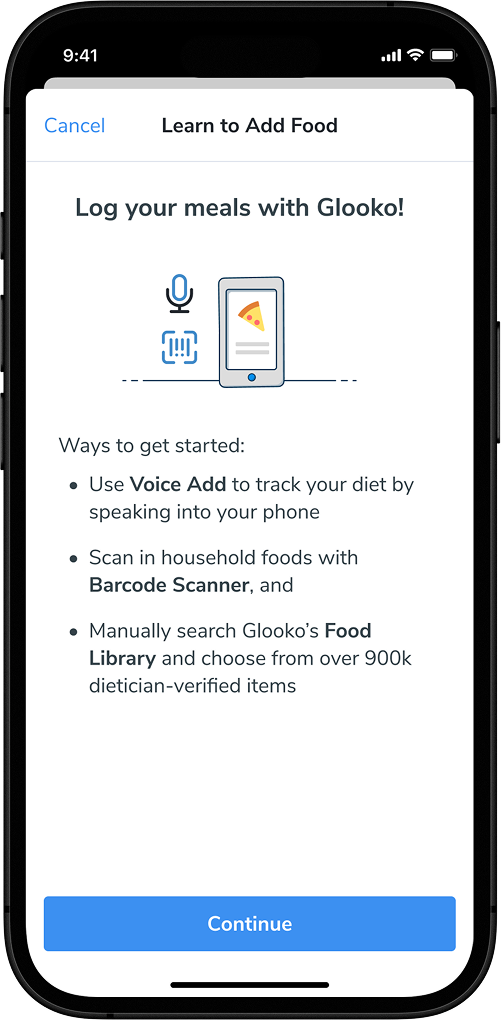 More ways to eat smart and track more effectively using the Glooko Mobile App
More ways to eat smart and track more effectively using the Glooko Mobile App
To better serve the diverse needs of users around the globe, Glooko has localized food items searchable in German, French, Spanish, Italian, UK English, and US English to support people living with diabetes in these regions.
Frequent users can also save time by creating custom food entries for their favorite meals — perfect for quick re-logging of their go-to foods.
To better serve the diverse needs of users around the globe, Glooko has localized food items searchable in German, French, Spanish, Italian, UK English, and US English to support people living with diabetes in these regions.
Glooko Mobile App users can complement their food logging with quick notes using free text or the dropdown menu option to provide details like miscalculated carbs, overeating, dining out, or skipped meals. These notes help communicate important context to their healthcare team who can provide more information dietary or medication recommendations as needed.
Share nutrition data with healthcare providers
While we’ve really focused on the benefits of food tracking for people living with diabetes, healthcare providers and care teams also benefit from this feature. They can view this logged nutrition data alongside their patients’ other health data in Glooko to have a more comprehensive view of everything affecting their patients’ diabetes.
The evolution of our food tracker
Glooko plans on further innovating its app to provide advanced food analysis tools, including micronutrients, more photos, and easier logging, and personalized nutrition insights with real-time feedback on how specific food choices directly impact a person’s health. An advanced, data-driven approach will empower people living with diabetes to make even timely, smarter, and more informed decisions about their health.
Download the Glooko Mobile App today
Ready to take diabetes management to the next level? Download the Glooko Mobile App from the App Store or Google Play Store and start logging food, tracking health data, and uncovering insights that support better living with diabetes.* *Not all product features are available in all countries.
*Not all product features are available in all countries.
![]()

Welcome back to my blog. I hope you’ve read my previous blog post on how to increase your daily physical activity and how to design an aerobic exercise program. In the previous post, I talked about how to design a new aerobic exercise program for yourself. This time, I’m going to discuss the benefits of adding resistance exercise to your exercise routine. I will explain some of the benefits of resistance exercise and will give you some tips on how to design and stick to your program.
*Just remember that before you start any exercise program, it’s always important to ask your healthcare provider to make sure you are medically cleared to exercise.
What is resistance exercise?

Resistance exercise, also called weight lifting or strength training is a mode of exercise in which you will use a form of resistance (body weight, elastic bands, weights) to build strength and increase muscle mass.
Benefits:
Resistance exercise is beneficial for many reasons. As we age, we lose muscle mass and bone density and research has shown that resistance exercise can help prevent the loss of both muscle and bone.
Additionally, since muscle tissue is sensitive to insulin, research also shows that by building more muscle mass and increasing insulin sensitivity, most individuals with diabetes can better manage their blood glucose.
There is also evidence that indicates adding resistance exercise and improving muscular health can be beneficial in helping us maintain independence in performing activities of daily living, preventing the risk of falls and injuries, and the risk of other age-related chronic conditions.
Programming:
Starting a resistance exercise program on your own can seem challenging, but by being aware of key factors and knowing how to address them, you can set yourself up for success. Here are important things to consider and how to approach them when beginning your resistance exercise program:
- Mode: You can choose between free weights (such as dumbbells and barbells), weight machines, resistance bands, or simply your bodyweight. It’s best to start with weight machines if you have access to the gym. Resistance bands and bodyweight exercises are also excellent options to start with and learn the movements especially if you don’t want to go to a gym.
- Intensity: For adjusting intensity, you need to determine your movements, weights, sets, repetitions, and rest period:
-
Movement selection: It’s always best to choose movements that involve more than one joint such as squat, deadlift, push up, row, and shoulder press. There are lots of variations to these exercises. For the start, let’s stay away from free weights (dumbbells and barbells) and instead do bodyweights (meaning use your own body weight as resistance), resistance bands, or weight machines.For bodyweight movements like squats and push-ups, your body weight provides the resistance. Focus on proper form and technique before adding external weight or resistance. If using resistance bands, choose bands with a level of resistance to match your current strength level. Start with a lighter band and gradually progress to heavier ones as you get stronger. If using weight machines, pay attention to how to load, unload, and adjust the machine for optimal body positioning.
-
Weight selection, sets, repetitions, and rest period: You can load your movements by adding weights, choosing different body positions, or using different bands. The more you load the movement (meaning the more you add resistance), the lower the number of repetitions. And you should always feel challenged towards the end of the repetitions in each set. For example when doing 3 sets of 8-10 repetitions, when you get to the 7th or 8th repetition in each set, you should feel that it gets noticeably more challenging. That’s how you know you have chosen the right amount of weights!
If it’s the first time doing resistance exercise, start with bodyweight movements, and bands and aim at doing 3 sets of 8-10 repetitions regardless of how hard it feels. As you get better at doing the movements and learn the technique, you can start using machines, free weights, or heavier bands and follow the rule above to choose the right amount of weights. When choosing machines and free weights, you can start with 2 sets of 10-12 repetitions and work your way up to 3 sets of 10-12 repetitions or 3 sets of 8-10 repetitions. Remember the lower the number of repetitions, the heavier the weights.
Also, you need to rest for 30 to 90 seconds between each set.
-
- Frequency: Start off with 1-2 times per week and aim at increasing it to 3 times per week.
- Duration: Always aim at completing about 8-10 exercises (3 sets of 8-10 reps) that cover major muscle groups in each session.
- Progression and variation:
- Progression and variations are two key elements to help you get stronger, build muscle mass, and help keep you motivated. You can do this by:
-
Changing the order of exercises you do
-
Doing different exercise variations (for example, if you’ve been doing barbell back squats, switch to front squats)
-
Changing the number of sets, repetitions, and weights
-
Choosing between machines, free weights, bodyweights, or resistance bands
-
- Progression and variations are two key elements to help you get stronger, build muscle mass, and help keep you motivated. You can do this by:
-
Exercise form and technique: Exercise form is crucial when doing resistance exercise. That’s why it’s recommended that beginners start with bodyweight exercises and resistance bands to learn and master movements first. Multi-joint movements such as squat, deadlift, shoulder press, chest press, and row all need practice. Never rush to begin loading your movements. If you are not sure of your technique, join a local gym and ask for a free personal training session. You can also use online resources such as this exercise library from American Council on Exercise (ACE).
Best Practices
Adherence is crucial to the success of any exercise program. Here are some valuable tips to help you stick to your new resistance exercise routine:

-
Pay attention to your form. Proper form and technique are important to avoid injury. One of the reasons people drop out of exercise programs is experiencing pain or injuries. So, make sure that you learn the proper forms and techniques with minimal loads before loading your movements. You can watch yourself in the mirror or even film yourself to see your form later.
-
Make it fun: Choose exercises and variations that you enjoy. If you like what you’re doing, you’re more likely to stick with it.
-
Prevent excessive muscle soreness. Pay attention to how your body responds after each workout. Some soreness is normal, especially when starting a new program or increasing intensity. However, excessive soreness that interferes with daily activities is a sign that you may have progressed too quickly. And let’s face it, excessive muscle soreness after exercise is not fun! You can avoid this by progressing slowly. For example, if your goal is to do 3 sets of 8-10 repetitions, increase the weights only when you can complete 3 sets of 10 repetitions without feeling excessive fatigue or soreness the day after.
-
Allow for recovery: Give your muscles time to recover between workouts. Adequate rest is essential for muscle repair and growth, as well as reducing soreness.
-
Be patient and realistic: Understand that progress takes time. Avoid comparing yourself to others and focus on your own journey.
-
Reward yourself: Celebrate your achievements, both big and small. Rewards can help reinforce positive behavior.
-
Overcome barriers: Identify potential obstacles and develop strategies to overcome them. Whether it’s lack of time, motivation, or resources, having a plan in place can help.
-
Monitor your blood glucose. Remember to monitor your blood glucose before, during (if possible), and after an exercise session to learn how your body reacts to your new exercise routine. Take a look at this resource from the American Diabetes Association (ADA) and see how you can get started safely with exercise while monitoring your blood glucose.
One way to keep track of your blood glucose is to download and use the Glooko app. You can also connect and sync your activity tracker app, including iHealth, Fitbit, or Strava, to Glooko. This way, you can see both your blood glucose and activity data in one place. This way, you can always review your own data and determine what works best for you.
Now, it’s time for you to start creating your resistance exercise program using the guidance above. I hope this information can help you in your journey to lead a healthier and happier lifestyle.
Yours in Health and Fitness,
Sanaz Nosrat, PhD, CSCS, ACE PT
MKT-0493 01
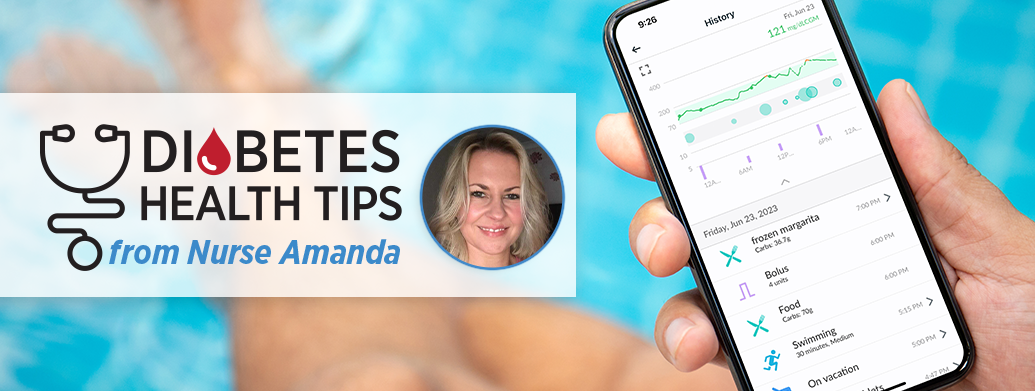
Welcome to a new series from Nurse Amanda full of useful health tips for people with diabetes! I’ve been a registered children’s nurse for over 23 years and I’ve had a special interest in diabetes for over 11 years.
To kick off this new series, our first blog post will cover travel. With school out for the summer, you may have a holiday booked. I certainly look forward to the family holiday every year. However, living with diabetes and organising a holiday is not just about what clothes to pack, it’s a whole load more. Diabetes also needs to be planned for during vacations.
TRAVEL TIPS
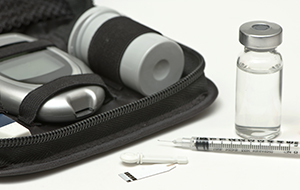 Set an alarm on the Glooko® Mobile App to remind you to order your consumables and GP prescription well in advance.
Set an alarm on the Glooko® Mobile App to remind you to order your consumables and GP prescription well in advance.- Take double the amount of equipment you need and carry it in your hand luggage. If you are travelling with a partner, split the equipment between both bags, just in case one gets lost. Sometimes airlines will permit extra luggage if they are contacted prior to arriving at the airport.
- Always wear some form of diabetes I.D. to alert others to your chronic condition.
- Make sure you have adequate travel insurance and the company has been made aware that you have diabetes.
- You can ask for a customs letter from your health care team to help you through security with your insulin and pen needles.
- Always carry some hypo treatment and be prepared to test your blood glucose more regularly. You could use a Bluetooth enabled blood glucose meter (BGM) to sync your results with Glooko for your care team to support you whilst you are away.
- If you use an insulin pump to manage your diabetes, some companies can provide a holiday pump service, so you can take a spare insulin pump with you. There’s no harm in asking. If this is needed, you can login to your Glooko account and see your latest device settings to programme the spare pump. Don’t forget to take your back up insulin pens as well!
- You can keep an eye on your glucose control through the recently redesigned Glooko® Mobile App.
- Track your food during your holiday with the Glooko Mobile App on your phone so you can see how different foods affect your diabetes.
- You may have a change in your activity levels. You can also track these within the Glooko® Mobile App to review how it affects your glucose control.
You also need to think about what kind of holiday it is. Will it be warm or cold?
TIPS FOR TRAVELLING IN HEAT
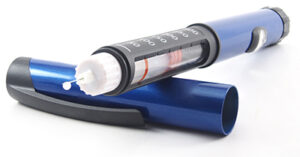 Please note, not everyone with diabetes will react the same to weather changes or changes in physical activity. Although some find heat can increase the sensitivity of insulin resulting in hypos, it is not always the case. Experiment how your body responds to heat changes and be fully prepared. You can keep a log of your symptoms in the Notes section of the Glooko app and also log any physical activity.
Please note, not everyone with diabetes will react the same to weather changes or changes in physical activity. Although some find heat can increase the sensitivity of insulin resulting in hypos, it is not always the case. Experiment how your body responds to heat changes and be fully prepared. You can keep a log of your symptoms in the Notes section of the Glooko app and also log any physical activity.
- Keep your insulin and meter as cool as you can without freezing it so the insulin does not get damaged.
- Store spare insulin in a cold or cool place. Most hotels have a fridge.
- If you are using an insulin pump, consider changing the insulin cartridge more regularly than at home, especially if your blood glucose is rising.
- Keep your pump and insulin out of the sun as much as possible. Consider using an insulin cooler bag.
- Your cannula may not stick as well being in and out of the pool or the suncream formula, so consider some form of extra adhesive.
COLD WEATHER TRAVEL TIPS
- Keep your BGM close to your body as much as possible to keep it warm.
- Add some extra wrapping around your BGM and insulin.
- If you’re sleeping in tents or somewhere cold at night, make sure your BGM is in bed with you next to your body. Be careful not to roll on it and cause damage.
- If the insulin has frozen or does not look clear with specks or lumps in it, throw it away and open a new vial.
Another worry may be if you are travelling across time zones and treating your diabetes with an insulin pump and basal settings. To alleviate anxiety, try these tips.
TIPS FOR TRAVELLING ACROSS TIME ZONES
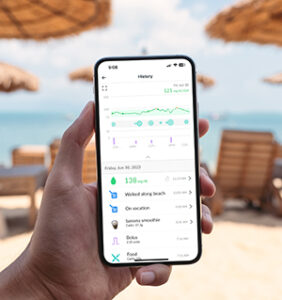 A time zone change of up to four hours can be managed by adjusting the insulin pump’s clock to the new destination time.
A time zone change of up to four hours can be managed by adjusting the insulin pump’s clock to the new destination time.
Time zone changes of four hours or more can be managed by adjusting the insulin pump’s clock by four hours before you board the plane. After a couple of days, you can change it to the destination time. On return, use the same method to revert back to your home local time. You can also set reminders in the Glooko app to alert you to change the time.
Remember to check blood glucose levels more frequently whilst doing this and treat any short-term complications accordingly.
I hope you follow my tips for a better diabetes management experience while travelling.
And most of all, enjoy your holiday!
Amanda Stoney, RN (CHILD), BSc (HONS), Specialist Practitioner, PG Certificate
MKT-0482 01
